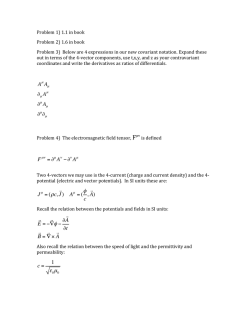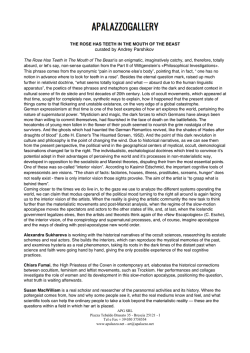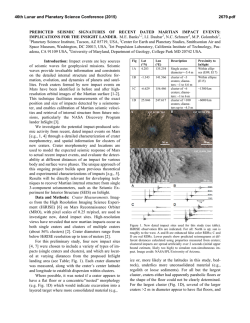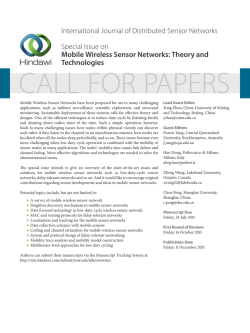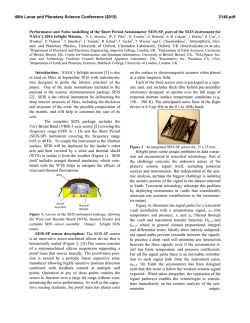
PROBING THE INTERIOR OF ASTEROIDS AND COMETS. J. B.
46th Lunar and Planetary Science Conference (2015) 2632.pdf PROBING THE INTERIOR OF ASTEROIDS AND COMETS. J. B. Plescia1, R. S. Miller2, H. Yu3, D. J. Lawrence1, and O. Barnouin1, 1Applied Physic Laboratory, The Johns Hopkins University, Laurel, MD 20723; 2 Deptartment of Physics, University of Alabama, Huntsville, AL 35899; 3School Earth Space Exploration, Arizona State University, Tempe, AZ 85287. Introduction: Asteroids and comets are the most numerous objects in the solar system and represent debris remaining after the accretion of the planets. Recent spacecraft observations of these bodies have shown that each has unique morphology that presumably reflects the variations in their geologic history over the last several billion years. A key question with regard these bodies is their interior structure. Asteroids have been suggested to be solid, regolith-covered bodies and debris piles [1-3] and comets have been suggested to be both rubble piles and homogeneously layered [4-5]. Images of Itokawa (Figure 1) and Comet 67P/Churyumov-Gerasimenko demonstrate that small bodies can have a complex history. Seismic probing: Seismic techniques provide an understanding of the interior structure of a body by determining the velocity and scattering of seismic waves through the interior. Seismic techniques are routinely used on the Earth for both local and global scale analyses; they have also been used on the Moon [6] and are about to be used on Mars [7]. A major drawback to using seismic techniques is that the sensor requires not only direct contact with the body, but also leveling. While direct contact can be easily achieved coupling of the sensor to the surface and leveling present more challenging problems. A new type of seismic sensor has been developed [by Hongyu Yu] in which leveling and a specific orientation are not a requirement. This sensor uses an electrolyte-fluid filled sensing cell. Ground motion causes the fluid to move generating a current that is measured and recorded. Because there are no moving parts, the system is orientation independent. Figure 2 illustrates a conceptual design of the sensor. Figure 1. Left: Asteroid Itokawa. Right: Comet 67P/Churyumov-Gerasimenko. While remote sensing measurements can define the surface morphology and identify surface composition, they provide few constraints on the interior structure. The key question is the extent to which these bodies are differentiated into layers and the extent to which they have a solid core or are rubble piles. Resolving the interior structure is critical to understanding the origin and evolution of these bodies. It is also relevant to future resource utilization and planetary defense efforts. In terms of planetary defense, the interior structure is of interest in terms of the consequences of the impact of such a body with the Earth. A body consisting of fragments will be weaker and more susceptible to atmospheric-breakup than a solid body. Techniques: Here we describe two techniques that could be used to probe the interior structure of a small body: seismic probing and muon radiography. Figure 2. Conceptual design of seismometer sensor package. Four sensors (blue) are mounted on perpendicular surfaces to provide 3-axis information. Muon radiography: This technique examines the propagation of muons through a body to reveal variations in the density (muon absorption). Cosmic ray bombardment generates muons from the decay of secondary mesons. The muons propagate through the body and are subsequently detected by a muon tele- 46th Lunar and Planetary Science Conference (2015) scope in orbit or station keeping with the body. By viewing the object from a range of positions provides a 3D image of the interior similar to X-ray tomography. Modeling studies [8-9] indicate that the muons can be used to probe the interior. Radon transform techniques provide the basis for a reconstruction of the interior density in analogy with medical tomographic techniques. Integrated radial density cross sections are obtained from each viewing geometry and these cross sections are in turn used to develop a 3D model. Deployment: For the muon radiography, the spacecraft would carry a single muon telescope. Depending upon the size the target body, the spacecraft could either enter orbit or conduct station keeping. In the station-keeping mode, the telescope could stare at the body until sufficient data are collected to provide a statistically significant data set. The spacecraft would then be repositioned to obtain a different viewing geometry (Figure 3). Modeling suggests that about several months of observation would be required to generate a cross section, dependent in part on the size and efficiency of the muon telescope employed. The dimensions of a muon telescope (meter-class scale would require a relatively large (with respect to a cubesat) spacecraft. It would also require an extended mission lifetime in order to obtain the data required for a 3D analysis of the body. This technique could provide very high spatial resolution of the interior - on the order of 10s of meters. A 3D understanding of the interior of a small body at the scale of 10s of meters would provide a unique data set to understand the evolution of a small body. Figure 3. Observational strategy for muon radiography. Muon paths are denoted by dashed lines; observational positions by the colored dots. There is however a limitation on the size of the body which could be completely penetrated by muons (~<0.5 km). In the case of larger bodies, profiles could be obtained of the limb region extending to some depth 2632.pdf (depending upon the density structure). While such observations would not reveal the deep interior, they might be sufficient to understand whether the body has a thin regolith over a more solid interior or if at least the surface consisted of rubble. The muon radiography concept is currently being modeled and matured as part of NASA’s NIAC program. For the seismic probing, the sensor must be emplaced on surface such that it is well-coupled. Because this sensor is small and does not require a specific orientation, a small cubesat-like spacecraft can be used to carry and deploy it. Depending upon the number of sensors to be deployed, a number of 1U cubesats could be combined, each for independent deployment. The deployed cubesats would communicate with a carrier, which in turn would communicate with the Earth. An outstanding question is the amount of energy that would need to be generated to provide sufficient energy for the seismic waves to propagate through the interior. A rubble pile would scatter energy increasing the amount required to propagate completely through the body. An artificial energy source would be required to probe the interior. Ideally, a number of seismometers would be deployed across the surface to generate a 3D image of the seismic velocity profile and the interior structure. At a minimum a seismometer would be placed antipodal to the point where energy would be input. Conclusions: We discuss two different techniques for understanding the interior structure of a small body - muon radiography and seismic probing. There are advantages and disadvantages to each approach. The muon radiography has the potential to proved very high resolution of the interior structure, but there is a limit to the size of the body that can be explored with this method and the instrument is large. The seismic probing technique has the advantage of being small and easily deployed on a cubesat scale mission. However, the spatial resolution of the interior structure would be relatively crude because of the limited number of stations. References: [1] Melosh, H., and Ryan, E. (1997) Icarus 129, 562-564. [2] Housen, K. (2009) PSS 57, 142-153. [3] Harris, A. et al. (2009) Icarus 199, 310318. [4] Weissman, P. (1986) Nature 320, 242-244. [5] Thomas, P. et al. (2013) Icarus 222, 453-466. [6] Nakamura, Y., et al. (1982) Proc. 13th LPS, JGR 87, A117-A123. [7] Banerdt, W., et al. (2013) LPSC XLIV, Abstract 1915 [8] Miller, R. and Lawrence, D. (2014) LPSC XLV, Abstract 1134. [9] Miller, R. and Cohen, T. (2006) Astroparticle Phys. 25, 368.
© Copyright 2026
